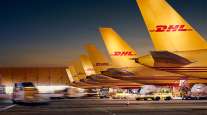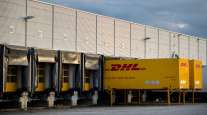Airfreight Prices From Europe Skyrocket in December

Airfreight rates between Europe and the United States surged in the final two months of 2017, hitting unprecedented levels in advance of the traditional volume spike from Asia that precedes the Chinese New Year in mid-February.
Prices typically fluctuate between $2.50 to $5 per kilogram (2.2 pounds) during the year, on average across all lanes, according to Drewry Shipping Consultants and rate management platform Freightos WebCargo, but may rise into the teens when demand exceeds capacity due to the business environment, a strike, weather delays or other incidents shutting or slowing operations in key airports around the world. Both have played a role in Europe.
At the end of November, unionized ground handling agents began a strike in Frankfurt, Germany, causing major delays through the international airport. The dispute was quickly resolved, but airfreight forwarder Dachser Logistics told customers before Christmas that there was still a “massive backlog of cargo, which has been hardly reduced in the face of ongoing high volumes of freight traffic.”
In certain situations, freight forwarders will pay a truck driver to haul the cargo to the Netherlands or France to bypass Germany, according to freight forwarders.
The Freightos Airfreight Index shows that European shipments to John F. Kennedy International Airport in New York range from $5 to $10 per kilogram, whereas the normal rate hovers between $1 and $1.30.
But on urgent, time-sensitive cargo the rates have in some cases exceeded $20 per kilogram.
“When I was being told the rates were $20 per kilo, I was calling the airlines to ask if it was a mistake, and the airlines would say, ‘No, no. It’s not a mistake.’ The market is crazy right now; it’s insane. I’ve never seen it before,” Freightos WebCargo CEO Manel Galindo said.
“I’ve never seen pricing go as high as this before, but customers are willing to pay more money to get items through the supply chain quicker. And given some of the problems we’ve experienced in Europe, it’s difficult to find any capacity at this point,” said Sean Daly, director of international services at Roar Logistics.
For the airlines, it’s simple supply and demand economics. They say that customers want to move more freight than the space available on their planes, so they’ll provide capacity to the customer willing to pay the most, a business practice well- known in the trucking industry.

Andrew W. Sleber/Flickr
The e-commerce industry also has driven up the demand to use airplanes given the speed that shoppers insist on these days. Amazon.com, FedEx Corp. and UPS Inc. have upgraded their capacity to satisfy the marketplace.
“It can be individualized shipments going to a customer from a distribution center, or generally in the case of our membership, it can be the restocking of these distribution centers,” said Brandon Fried, executive director of the Airforwarders Association. “When you have volumes leaving these distribution centers at such a quick pace, you cannot always wait for a containership or a truck to get the pallet [with cargo] to its destination.”
From Asia to the United States, technology giant Apple Inc. shifted the calendar back when it delayed the release of the iPhone X until November. The two-month delay versus the typical iPhone release date meant the capacity allocated to transporting the expensive smartphones was pushed closer to the holiday season.
Like in Europe, some freight forwarders used trucks to counter the prices in certain countries.
“In Vietnam, an emerging market, there are three or four major multinational exporters that take up a significant amount of the air capacity. So we’ve had situations where retailers were willing to truck freight from Vietnam to Hong Kong, where there is more capacity,” Seko Logistics President James Gagne said.
Rates from Asia aren’t as hot as in Europe, but demand likely will grow between now and the Chinese New Year on Feb. 16, similar to the ocean container sector. Nevertheless, Galindo doesn’t believe the airfreight rates will climb as high as Europe because the Chinese New Year is a recurring, annual event with a predictable supply chain.
The year ends on a high for both ocean and air #freight rates. But they will face different fates before the CNY rush kicks in https://t.co/t1vngQCdhM pic.twitter.com/65RDHDz76X — Freightos (@freightos) December 28, 2017
For the cargo owners not in a hurry, using a containership can provide a welcome relief to the bottom line. The Freightos index shows that the spot rate from China to the West Coast is $1,562 per industry standard 20-foot-equivalent unit (TEU), down 29% from a year ago. On the East Coast, rates are down 25% from China ($2,547) and 28% from Europe ($1,560).
“The problem [with depending on ocean freight] is that demand forecasting tools are still really in the early days,” Gagne said. “Both in the brick-and-mortar and e-commerce sides, forecasting is extremely difficult to get exactly right, so there is plenty of demand for last-minute airfreight.”
Industry insiders anticipate capacity will tighten further in the coming years between Asia and the United States given the rising middle class in China.
DHL Global Forwarding Vice President Paul McMillan said at a media briefing in New York on Nov. 30 that airfreight capacity from Asia to North America was already “at the brink,” and with 25% of the population in China projected to buy goods online by 2020, airfreight shipments from the United States might eventually exceed the volume of goods imported from Asia.
DHL began an around-the-world freighter service with two dedicated aircraft to handle the peak shipping season but will continue offering the service into 2018 because of the expectation of increased cross-border e-commerce shipments.
Staff Writer Daniel P. Bearth contributed to this article.




